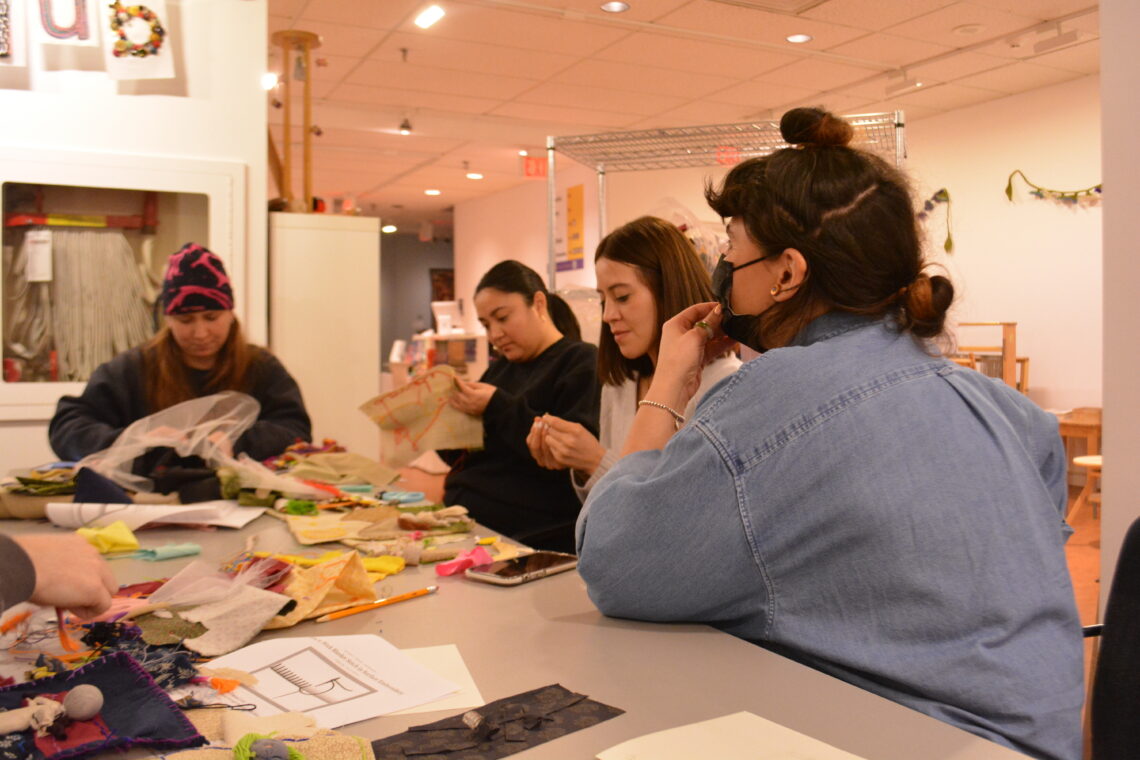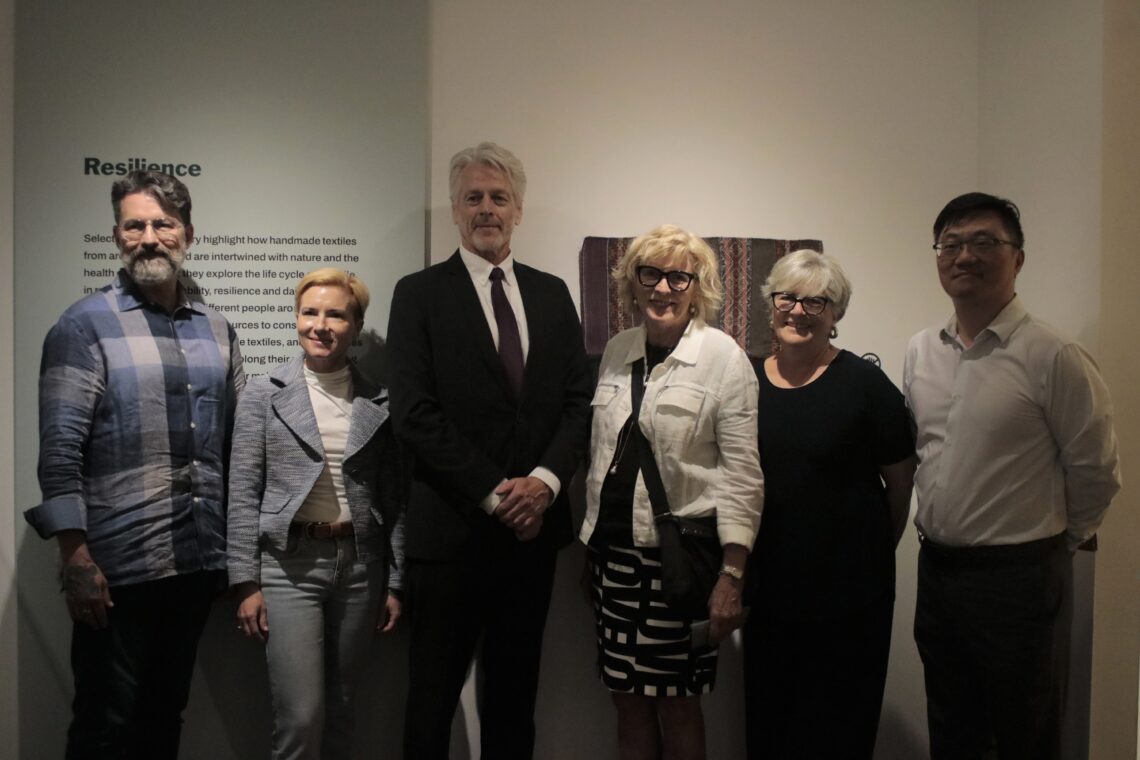Textile Museum of Canada seeks new Director & CEO
Boston-based search firm Arts Consulting Group (ACG) has been retained by the Textile Museum of Canada to aide in the search for its next director and CEO.
Organization
The Textile Museum of Canada (Textile Museum) is the only museum in Canada delivering programs andvexhibitions dedicated solely to textile arts, and it is one of eight worldwide exclusively devoted to the collection, exhibition, and documentation of global textiles. Based in Toronto for more than 45 years, the award-winning Textile Museum explores local, national, and international social and cultural histories through the medium of textiles and how they inform contemporary art, craft, design, and human histories. It serves as a national cultural institution anchored in the local community, reflecting the evolving richness and diversity of cultural experiences through the fabric and art of everyday lives. The museum’s agility and responsiveness to contemporary issues and its resulting innovative research, exhibition, educational programs, and outreach not only ensure robust community engagement, but also relevance to local, national, and international audiences.
As a Canadian, charitable, non-profit cultural and educational organization with an accomplished and dedicated curatorial staff, the Textile Museum focuses on the exhibition, collection, conservation, and research of textiles, as well as the production of inclusive public programs that foster awareness of the diverse cultural values of textiles and textile practices. Its core vision is to inspire understanding of human experience through textiles; to ignite creativity, inspire wonder, and spark conversation and learning through the stories held within its international collection; and to ensure constant active engagement with both historic and contemporary artistic practices. The Textile Museum has also nurtured and supported a Creative in Residence program through a seed grant for emerging artists that it hopes to continue with additional funding.
In addition to 12,500 square feet of public space, the museum is innovative in its approach to interactive, digital platforms. It has a specialized reference library, conservation department, gift and book shop, and collections management and research area to support the Textile Museum’s operations. An auditorium for meetings and seminars, as well as an education gallery, provide space for public programming and hands-on, interactive experiences.
The Textile Museum’s collection consists of more than 15,000 objects. Among them, for example, are a salmon skin suit from China, a rain hat made of rice straw, seaweed, and tree bark from Japan, a woman’s silk coat (munisak) with warp ikat designs from Uzbekistan, and a hooked rug by artist Florence Ryder (Standing Buffalo Reserve, Saskatchewan) that incorporates traditional Sioux designs. While only a small percentage of the collection is available for viewing in the Textile Museum’s galleries, the complete collection from more than 200 regions of the world has been digitized and is available for viewing online. The Textile Museum’s exhibitions also present the work of local, national, and international contemporary artists who often draw from the museum’s permanent collection for research and inspiration.
In solidarity with Black, Indigenous, and People of Colour (BIPOC) communities, the Textile Museum made a public statement on June 12, 2020, in support of the Black Lives Matter movement. The statement challenged the Textile Museum to turn the lens of equity inwards to explore how the museum can further develop a deeper sense of belonging for all. Even prior to this public statement, the Textile Museum has been committed to taking an active role in the ongoing struggle for racial equity and justice. Recognizing that the Textile Museum, like so many cultural institutions, has been shaped by the colonial roots of Western museum practices and histories, the museum has committed to publicly sharing its plan for concrete actions towards meaningful change.
The Textile Museum continues to confirm its longstanding commitment to representing the evolving diversity of Toronto, Ontario, and Canada. It will proceed with transparency to review its responses to equity, diversity, and inclusion by establishing benchmarks to measure its progress as outlined in the Textile Museum of Canada Equity, Diversity, and Inclusion Plan. These initiatives will be reflected in Textile Museum’s projects, partnerships, people, policies and procedures, educational programs, collection, exhibitions, and daily operations.
Led by Board Chair Judith E. Harris, the Textile Museum board consists of 13 trustees representing diverse sectors such as academia, law, architecture and design, finance, human rights, art history, public attractions, and the arts. The museum is managed by 14 dedicated staff members who are assisted by a robust staff-led volunteer corps along with paid interns who are funded by various universities and the Young Canada Works in Heritage Organizations program. Approximately 40 percent of the Textile Museum’s $1.3 million operating revenues is generated from government and granting agencies. The Textile Museum also historically had 30 percent of its budget in earned revenue from memberships, admissions, tours, and its shop and 30 percent in contributed revenue from individual, foundation, and corporate supporters. It seeks to further advance its impacts by growing its philanthropic base in the future.
Community
Toronto is located on the Treaty Lands and Territory of the Mississaugas of the Credit First Nation and the traditional territory of the Anishinaabe, Wendat, and Haudenosaunee. The territory is within the lands protected by the Dish With One Spoon Wampum Belt Covenant, an agreement between the Haudenosaunee and Anishinaabe and allied nations to peaceably share and care for the resources around the Great Lakes. Today, the meeting place of Toronto (also known as Tkaronto) is home to many Indigenous people from across Turtle Island and the various stakeholders of the Textile Museum are grateful to work on this land.
Toronto is the largest city in Canada with a population of three million people. More than six million people call the Greater Toronto Area (GTA) home. Its demographics are approximately 50 percent white, 13 percent East Asian, 12 percent South Asian, 9 percent Black, 7 percent Southeast Asian, 3 percent Latin American, 2 percent West Asian, 1 percent Arab, and 1 percent Indigenous. The United Nations has also designated Toronto as the most diverse city on the planet with more than 50 percent of the population being foreign born.
In 2016, the time of the last census, there were more than 164,000 culture jobs in the City of Toronto, accounting for 90 percent of all culture jobs in the GTA and more than half of total cultural employment in Ontario. In addition to numerous museums and performing arts organizations, large-scale special events can be found every weekend of the year. Several signature music and performing arts events in the city include Nuit Blanche, Luminato Festival Toronto, Pride Toronto, Canadian National Exhibition, Toronto Caribbean Carnival, Just for Laughs Comedy Festival, and Toronto International Film Festival, among many others. Toronto was the first city in Canada to be designated as a Creative City of Media Arts by the United Nations Educational, Scientific, and Cultural Organization (UNESCO).
The Textile Museum resides in a neighbourhood that has been shaped by textiles for more than a century. Originally located in Toronto’s Mirvish Village, the Textile Museum moved to the city’s historic Garment District in 1989. The area was home to numerous textile and fabric factories and warehouses in the early 1900s due to the area’s proximity and easy access to shipping and rail lines. Garment enterprise owners commissioned the construction of multi-story buildings to house their manufacturing operations. The Garment District was one of the few areas populated by Toronto’s Jewish community, many of whom worked in the textile industry.
Toronto has had an increasing impact on global popular culture due to the rise of hip-hop stars like Drake and The Weeknd. Vogue magazine declared Toronto’s West Queen West neighbourhood the “second coolest neighbourhood in the world.” The Toronto Raptors also brought international attention to the city with its 2019 NBA Championship win, the first to be played outside the United States. With more than 8,000 international restaurants to choose from, the food scene in Toronto is one of the world’s finest and most eclectic.
Toronto has four universities, four colleges, and 128 specialised research centres. The University of Toronto has been ranked 18th in the world for the third consecutive year in the prestigious Times Higher Education World University Rankings. Toronto is the fastest growing technology market in North America, with 80,100 jobs created— greater than the job growth in New York City, Seattle, and Boston combined. The city has also been undergoing a construction boom over the last decade. This increased commercial development is coinciding with major transportation upgrades, including the $640 million revitalization of Union Station, Canada’s busiest transportation hub. Toronto also plays a significant role in the global film industry, serving as a filming location for numerous television shows and movies.
Position Summary
The Director & CEO will provide visionary leadership for the Textile Museum and develop and execute a new strategic plan that advances the Textile Museum’s mission, vision, values, and goals. Reporting to the Board Chair, the Director & CEO will oversee the museum’s curatorial focus and public visibility locally, nationally, and internationally. This individual will identify, cultivate, and secure revenues for the Textile Museum’s growth as an institution in service to its diverse community. The Director & CEO will lead fundraising efforts from public and private sector sources and be an active participant in current cultural conversations concerning equity, diversity, inclusion, and access. This individual will lead, direct, and mentor Textile Museum staff, oversee operations, and ensure efficiency, quality, and cost-effective management of human, financial, and technological resources.
Roles and Responsibilities
Strategic Leadership and Public Visibility
- Embody the role of primary ambassador for the museum, working with the board, staff, and other stakeholders to communicate its curatorial goals, mission, vision, and values to local, national, and international audiences.
- Develop relationships with key strategic partners in communicating Canada’s role in textile and fabric history, as well as highlighting international global influences.
- Cultivate relationships with and connections between government agencies, the media, museum members, and funding partners.
- Lead conversations around equity, diversity, and inclusion, with a deep awareness of implementing the recommendations of Canada’s Truth and Reconciliation Commission.
- Engage in a strategic planning process that gathers input from various stakeholders, including the board, staff, government officials, donors, members, and the public.
- Create strategic partnerships with public and private organizations, with particular attention to developing ties to the non-profit and education sectors.
- Partner with curators, educators, and directors from other institutions to strengthen the alignment, focus, and quality of educational, training, and paid internship programs.
- Facilitate working sessions with staff and encourage cross-sector and inter-institutional dialogue on exhibitions and educational opportunities.
- Ensure collection, conservation, and research policies are clearly articulated in considering acquisitions and deaccessioning in regular conversations with the board.
- Perform other strategic leadership and public visibility responsibilities as needed.
Revenue Enhancement and Audience Engagement
- Lead and participate in all aspects of fundraising activity, including oversight of grant writing and public presentations to government agencies.
- Identify, cultivate, and secure support from foundations, business partners, sponsors, and major individual donors to ensure diversity in available funding sources.
- Collaborate with and guide the board in its fundraising role, supporting its efforts to attract new donors in all giving categories.
- Formulate a strong and far-reaching fundraising strategy and donor cultivation program that will move the Museum to a more robust financial position
- Grow diverse community participation in and accessibility to the Textile Museum with the goal of increasing membership and audience engagement.
- Determine best practices in community engagement through a collaborative process with diverse local communities and socially innovative organizations.
- Lead ongoing initiatives to support the digitization and broader awareness of the museum’s collection.
- Extend the reach of the Textile Museum to augment its offerings through online, social media, and digital exhibition and educational programs.
- Identify new individual donor prospects and steward existing donors with an emphasis on how to effectively drive major gifts from local and national sources.
- Develop multiple streams of revenue from foundation prospects, corporate sponsors, and special event entities
- Perform other revenue enhancement and audience engagement responsibilities as needed.
Organizational Capacity and Mentorship
- Oversee staff in programming, venue operations, finance, development, marketing, and communications through mentorship and collaboration.
- Communicate a sense of appreciation for the professional and personal commitments that are made by the staff, board, and a large and dedicated volunteer force.
- Commit to advancing the Textile Museum’s equity, diversity, and inclusion plans with both the board and staff to ensure that the museum, its workforce, and volunteers reflect the communities it serves.
- Build and nurture strong relationships with board members and the board as a whole.
- Recommend best practices and procedures to the board to better support its community ambassadorship, fundraising, and policy-making functions.
- Collaborate with the board to identify, cultivate, and recruit more diverse professional and cultural participation on the board.
- Guide succession planning in the curatorial and collections area of the museum.
- Serve as a liaison to various board committees and task forces.
- Encourage the continual professional development of the staff and board, as well as appropriate training of volunteers.
- Perform other organizational capacity and mentorship responsibilities as needed.
Financial Management and Resiliency
- Develop and implement a path towards sustainable growth with clear organizational and financial metrics in alignment with the new strategic plan.
- Balance available human, financial, and technological resources with staff capacity and output to maintain measured growth.
- Ensure that financial matters of the Textile Museum are predicated on clear communication and collaboration with the Board Treasurer and the Finance Committee.
- Determine the optimal use of capital and operating funds for facilities, equipment, technology, and operations in discussions with the Finance Committee.
- Collaborate with the staff to prepare financial reports, budgets, and plans in a timely fashion to ensure that board members are regularly apprised of the organization’s fiscal health.
- Maintain effective internal controls related to all financial matters, with appropriate checks and balances between departments and with the board.
- Regularly review the effectiveness of the organizational structure, policies, system controls, and procedures.
- Perform other financial management and resiliency responsibilities as needed.
Traits and Characteristics
The Director & CEO will be a thoughtful listener who draws insights and inspiration from a variety of internal and external stakeholders. Motivated by the aesthetic and educational nature of textiles and receptive to new ideas, the Director & CEO will be a resourceful leader who values collaboration, teamwork, and mentorship. This individual will be innovative, people oriented, adaptable to changing circumstances, and a visible community presence locally and nationally. The Director & CEO will have both business savvy and emotional intelligence in how best to align stakeholder interests around common goals and outcomes. This individual will exemplify a commitment to diversity in all forms and cultivate social inclusion in a meaningful way. An intergenerational connector between long-serving and newly arrived board members, staff, and volunteers, the Director & CEO will embrace a culture that ensures institutional knowledge is widely shared and celebrated.
Other key competencies of this role include:
- Leadership and Diplomacy – The ability to motivate, engage, and inspire with a clear organizational direction and purpose throughout all Textile Museum communities and conciliatory processes whereby tactful interactions allow all stakeholders to feel heard and appreciated.
- Planning, Organization, and Priority Management – The capacity to chart a path forward by outlining clear steps and methodologies where intended actions and outcomes are in a structured, prioritized, and well-documented process.
- Flexibility – The agility to be nimble and responsive with regard to shifting priorities and tasks, striving to adapt to change and stepping outside one’s comfort zone.
- Continuous Learning – The ingenuity to stay abreast of trends and disruptions in the museum field and the arts and culture sector through diligent, self-motivated study and research and to demonstrate a commitment to the professional development of the team.
- Understanding and Appreciating Others – The integrity to treat all internal and external stakeholders with respect as unique individuals, requiring sensitivity and care to facilitate their ongoing dedication and contribution to the Textile Museum.
Qualifications
Several years of senior management expertise in museums, the arts, non-profit organizations, creative industries, or related social enterprises is required. Advanced education or training is appreciated. Demonstrable results in advancing Truth and Reconciliation, as well as well equity, diversity, inclusion, and access initiatives, is required. Experience supervising staff, collaborating with non-profit boards, managing a budget, and expanding revenues is needed. Superior written communication and verbal presentation skills are expected. Passion and affinity for textiles in both their historical and contemporary contexts are needed. International candidates will be considered but Canadians and those who are currently eligible to work in Canada are preferred.
Compensation and Benefits
The Textile Museum offers competitive compensation, anticipated in the range of $115,000 to $130,000, plus benefits that include supplemental health, vision, and dental insurances; paramedical services; long-term disability and life insurances; employee and family assistance programs; and paid vacation and holiday time; among other benefits.
Applications and Inquiries
To submit a cover letter and resume with a summary of demonstrable accomplishments (electronic submissions preferred), please click here or visit artsconsulting.com/employment.
For questions or general inquiries about this unique job opportunity, please contact:
Dr. Bruce D. Thibodeau, President
Mr. Menon Dwarka, Senior Vice President

2 Toronto Street, Suite 217
Toronto, Ontario M5C 2B5
Tel (888) 234.4236 Ext. 201 (Dr. Thibodeau) or Ext. 206 (Mr. Dwarka)
Email: TextileMuseum@ArtsConsulting.com


